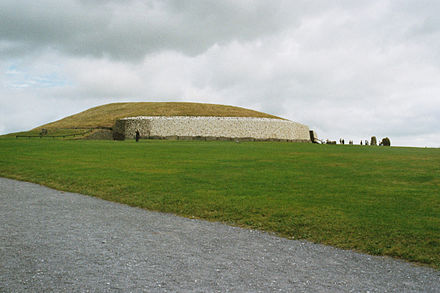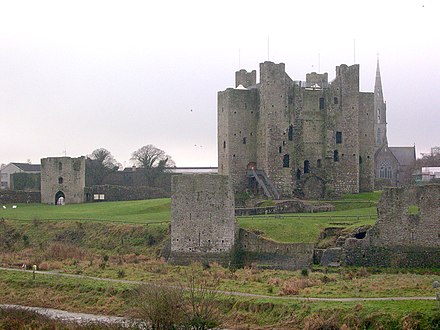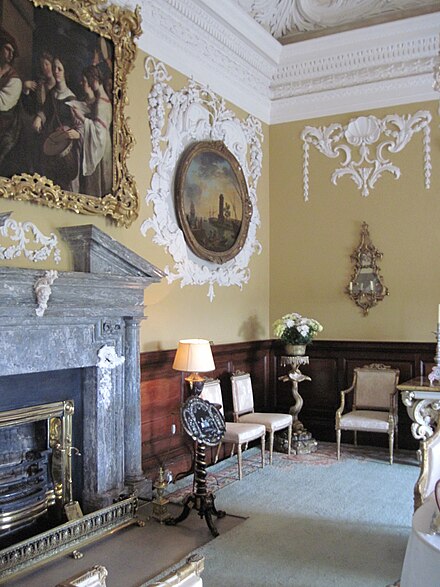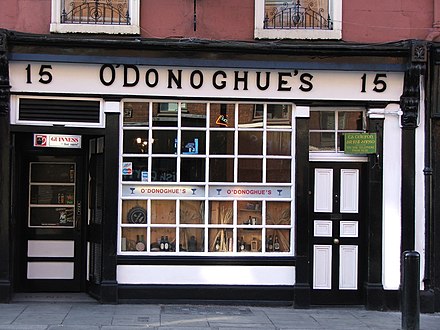East Coast and Midlands
East Coast and Midlands
East Coast and Midlands is a region of Ireland, centred on Dublin and roughly corresponding to the ancient kingdom of Leinster. It's never been a unit of government, it's simply a collection of counties for statistical and planning purposes, known to the lyrical Irish as "NUTS Level 2 - IE06". It consists of three subregions: Dublin (IE061, population 1,345,402 as at 2016), Mid-East (IE062, Counties Kildare, Meath, Wicklow and Louth, population 688,857) and Midlands (IE063, Counties Laois, Longford, Offaly and Westmeath, population 292,301).
Counties
It's more than the city: the coast has a series of old harbours, fortifications and breezy headlands.
You're probably here for the races and the National Stud.
For Emo Court, Rock of Dunamase, Timahoe Round Tower and Slieve Bloom mountains.
Of all its prehistoric sites, the oddest is the track into Corlea bog.
This has prehistoric and medieval ruins aplenty, and long sandy beaches.
Here are Hill of Tara, Brú Na Bóinne, Kells Abbey and Loughcrew Cairns.
See Clonmacnoise and the highs and lows of Victorian astrophysics and Georgian aviation.
For historic Athlone on the Shannon, and the dark story of Belvedere House near Mullingar.
Its mountains enfold monastic Glendalough, and form the backdrop to great mansions at Powerscourt and Russborough.
Cities and towns
- Dublin is the lively unmissable capital of Ireland.
- Bray on the Dublin / Wicklow boundary is a resort town with a scenic headland.
- Malahide at the other end of County Dublin has a restored castle.
- Trim has a well-preserved Norman castle and is near sites such as Hill of Tara.
- Drogheda is a historic city and a good base for reaching Brú Na Bóinne.
- Kildare 📍 has a cathedral with a fine Round Tower, and is near the Irish National Stud.
- Portlaoise is a workaday place but it's near the bastion of Rock of Dunamase.
- Tullamore is best known for its two whiskey distilleries.
- Athlone on the Shannon has a sturdy castle and a pub dating from 900 AD.
Other destinations

- Brú Na Bóinne Archaeological Park is a remarkable Neolithic site, with Newgrange its best known feature.
- Glendalough is an extensive monastic complex in a scenic mountain valley.
- Clonmacnoise 📍 is a medieval monastery on the banks of the Shannon.
Understand
In the souvenir tea-towel version of Irish history, Leinster was the large eastern territory of the four that made up Ireland, the others being Munster, Ulster and Connaught, with a High King presiding over all. In reality in early medieval times there were more like a dozen, forever warring and shifting boundaries, and recognising no overlords. The Normans arrived in the 12th century and began a land-grab, starting in the fertile lowlands of the south and east, and divided Ireland into shires or counties. Resistance from Leinster was a tad stiffer than they cared for, so they effectively bribed that kingdom to keep quiet. They also subdued Meath the kingdom to its north, and this became absorbed by Leinster, creating something like the present East Coast and Midlands Region.
The Normans pushed on west but were thrown back by the Gaels, and weakened by plague and internal strife. They held onto Dublin and an arc of territory - "The Pale" - extending roughly 150 km out, and it was only from the 16th century that the English Tudors were able to resume conquering the rest. The battles fought in Leinster were extensions of those in Great Britain: Cromwell's ruthless campaign against the Royalists, and King James' rearguard action against the Protestant King William. Thereafter, peace for the most part, and the region developed agriculture, industry and transport on modern lines. Georgian Leinster was very much part of Britain, with Dublin constructing its elegant wide streets and leafy squares, and even the formerly "beyond the Pale" County Offaly witnessing the world's first aviation disaster, cutting-edge astronomy, and the world's first automobile fatality. In the 19th century canals then railways snaked across terrain that was little impeded by mountains or bogs, and all these routes focussed on Dublin. They still do.
This meant that even before independence in 1921, the area was heavily built upon and its antiquities rifled or ploughed under. That build-up has continued in the century since, so it's remarkable how much heritage remains. There are prehistoric monuments older than the pyramids, ancient Christian sites, much-battered castles and stately mansions. Dublin is the place to start exploring because, quite apart from having the visitor amenities and transport connections, its excellent museums display the best of the region, indeed the best of the country. But you do need to get out from the city to the many places that can only be experienced on site. The region is promoted by the national tourist agency as "Ireland's Ancient East".
Get in
 Dublin Airport (IATA: DUB) is at the north edge of the city. It has a wide choice of flights at competitive fares, and direct buses across the entire region.
Dublin Airport (IATA: DUB) is at the north edge of the city. It has a wide choice of flights at competitive fares, and direct buses across the entire region.
Trains run to Dublin Connolly from Belfast, Sligo and Rosslare ferry port, and to Dublin Heuston from Galway, Limerick, Cork and Waterford.
Ferries sail to Dublin port from Liverpool, Holyhead and the Isle of Man. Dún Laoghaire is no longer a ferry port.
Motorways and bus routes radiate out from Dublin, so you can reach this region within 3 hours from almost anywhere in Ireland.
Get around
By train
See Irish Rail for timetables, fares and online tickets. Because the railways radiate from Dublin across lowland terrain, they're a good travel mode between the towns along them.
Dublin Connolly has trains from Belfast stopping at Dundalk and Drogheda; from Sligo stopping at Longford, Mullingar and Maynooth; and from Rosslare stopping at Arklow, Wicklow Town, Bray and Dún Laoghaire. Connolly is also the hub of DART suburban services to the coastal towns of Malahide, Howth, Dún Laoghaire, Dalkey, Bray and Greystokes - inter-city trains ply the same track but mostly rush through these places.
Dublin Heuston has trains from Galway and Mayo stopping at Athlone, Clara, Tullamore, Portarlington and Kildare. From Limerick and Cork they stop at Portlaoise, and from Waterford they stop at Kildare. Commuter trains also serve Naas.
Connolly and Heuston stations are 5 km apart so journeys involving separate lines are less convenient. For instance between Wicklow Town and Kildare you'd have to travel into Dublin, take the cross-city tram then travel out again.
By bus
_(30679439745).jpg/440px-Irish_National_Stud,_Co._Kildare_(506994)_(30679439745).jpg) Buses from Dublin city and airport run everywhere but seldom stop while crossing the region. Some you might use are:
Buses from Dublin city and airport run everywhere but seldom stop while crossing the region. Some you might use are:
- Dublin - Sligo / Ballina bus calls at Maynooth, Mullingar and Longford.
- Dublin - Galway bus calls at Maynooth and Athlone.
- Dublin - Limerick / Kerry bus calls at Kildare.
All the other main towns have direct daytime buses from Dublin. There are night buses to Naas, Kildare and Portlaoise, and to Ashbourne, Navan and Kells.
Cross-country inter-city buses are sparse, but radiating from Athlone are buses to Mullingar, to Tullamore, Portlaoise, Carlow and down through the midlands to Waterford, and to Longford and Monaghan.
See individual towns for other short-haul connections, urban buses (Dublin has a huge network) and the Local Link buses that wind through the back lanes.
By car
 Car rental is best arranged from Dublin airport, or at a pinch from the city. Book in advance for the best deals and to ensure availability.
Car rental is best arranged from Dublin airport, or at a pinch from the city. Book in advance for the best deals and to ensure availability.
The main roads radiate from Dublin, with M50 (toll) ringing the city, and a motorway tunnel (toll) between the port area and the M1 / M50 junction. These roads are fast unless you catch commuter rush hour. The principal routes are:
- M1 Dublin - airport - Drogheda (toll) - Dundalk - Belfast
- M3 / N3 Dublin - Navan - Kells - Cavan - Enniskillen - Donegal
- M4 / M6 Dublin - Athlone - Galway, with N4 for Mullingar and Sligo
- M7 Dublin - Portlaoise - Limerick, with M8 for Cork, and M9 for Carlow, Kilkenny and Waterford
- M11 Dublin - Bray - Wicklow - Wexford
See

Dublin
- Dublin city will take you some time to absorb. The best of it is south of the river, from Merrion Square and Trinity College to the Castle.
- Small harbours and resort towns lie along the coast, such as Howth, Dun Laoghaire and Dalkey.
- Malahide has a fine castle-cum-mansion.
Kildare
- Just outside Kildare town are the Japanese Gardens and the Irish National Stud.
- Castletown is a great Palladian mansion at Celbridge that often hosts events; it has two wacky Follies.
Laois
- Slieve Bloom Mountains form the border with County Offaly.
- Abbeyleix has a bog that's notable even by Ireland's demanding standards, with a 3.5-km boardwalk.
- Rock of Dunamase is a rocky outcrop and castle east of Port Laoise.
- Emo Court is a 19th-century neo-classical mansion northeast of Port Laoise.
- Gash Gardens are in Castletown, while Heywood Gardens are in Ballinakill southeast of Abbeyleix.
Louth
- Drogheda has many traces of its turbulent history; Old Mellifont Abbey lies north.
- The Cooley Mountains look across a fjord to Mourne Mountains in Northern Ireland.
Meath
- Brú Na Bóinne Archaeological Park is one of Ireland's top sights.
- The site of the Battle of the Boyne is nearby.
- Hill of Tara was the ceremonial seat of the High Kings of Ireland.
- Celtic High Crosses in Kells - but the famous book is nowadays in Dublin.
Offaly

- The monastic site of Clonmacnoise has large Round Towers and beautifully decorated high crosses.
- Charleville Castle in Tullamore is gothic, set in an ancient oak forest.
- Durrow Abbey is an early monastic complex.
Wicklow
- Glendalough is a monastic town with ruins and a Round Tower.
- Powerscourt near Enniskerry has an impressive mansion, gardens and waterfall.
- Kilmacurragh is a botanical garden and arboretum 5 km west of Wicklow town.
- The Wicklow Mountains rise to 925 m, with bog, conifer and gorse, and lots of scenic walking trails.
Do
- Go to the races at Leopardstown south side of Dublin, The Curragh in Kildare (which hosts the five Irish Classic Horse Races), Punchestown near Naas which is a steeplechase course, or Fairyhouse in Meath.
- Play golf: lots and lots of courses especially on the Dublin outskirts.
- The Grand Canal and the Royal Canal stretch from the Liffey all the way west to the Shannon. They're navigable and have good towpaths.
- The Wicklow mountains start just south of Dublin, with Lugnaquilla at 925 m. The Slieve Bloom mountains further west only reach 527 m with Arderin.
- Long distance trails could take 2-3 days, or be broken up into easy hikes, such as the Wicklow Way, Offaly Way and Westmeath Way.
Eat

- Dublin has got the lot.
- Wicklow: Good spots are Roundwood Inn in Roundwood, Strawberry Tree in Aughrim, Happy Pear in Greystones and Ashford Oriental.
- Kildare: Naas and Kildare town have the most choice.
- Offaly: There's a good selection in Tullamore and Edenderry.
Drink
- Dublin around Temple Bar is tourist-trappy, with raucous hen parties upchucking onto the cobbles. Go a little way west or south for pubs of real character.
- Distilleries: Old Jameson Distillery in Dublin is on the tourist circuit but no longer in production, try Teelings. There are several in other towns, and Tullamore has both the D.E.W. and the Kilbeggan distilleries.
- Ancient pubs: the Brazen Head in Dublin claims to date from 1198 AD but is only documented from 1668. But Sean's in Athlone goes back to circa 900 AD.
Stay safe
Wrap up well in the Wicklow mountains, but the area is mostly lowland and the hazards are man-made - especially traffic.
Go next
- All the transport routes radiate out from Dublin, so a few hours on the road will bring you anywhere across Ireland.
- This region stretches to the border at Dundalk, so next stop north is Northern Ireland. Belfast and the Giant's Causeway are the big draws, but don't overlook the Mourne Mountains or Antrim glens.
- Southeast Ireland has attractive Waterford, Wexford and Kilkenny.
- West cross the bogs and low-lying fields into Shannon Region and West Ireland, with prehistoric sites, the cities of Limerick and Galway, the Atlantic crashing against the Cliffs of Moher, and a scattering of small islands.